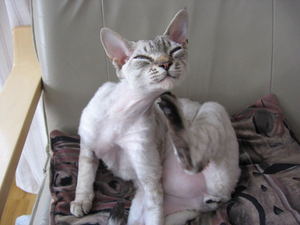They start as small, round bald patches on the face or legs of a cat or kitten. The edges of the bald spots are often ringed with red. This is the ring that gives ringworm its name, although it is caused by a fungal infection and not by a worm. Ringworm or dermatophytosis often progresses to the point where the cat becomes mostly bald. Cats and kittens can get infections from scratching the skin open and their claws can become malformed from the constant contact with the fungus. A multi-faceted treatment is a must in order to succesfully eradicate ringworm from catteries and homes.
Medications
Part of ringworm treatment is anti-fungal medication given in pill or liquid form. According to Mar Vista Animal Medical Center, the most common medications used are griseofulvin, which works well in all cats except young kittens, Persians and cats diagnosed with feline immunodeficiency virus. The other medication available for cats is itraconazole.
If the cat is really badly infected, then drastic measures like dips can be used. There is also the option of using anti-fungal shampoos in addition to other medications or topical ointments. Human athlete’s foot creams that can be purchased over the counter can certainly help kill ringworm spores. Athlete’s foot is caused by another type of fungus. When in doubt, please contact your vet before using any human over the counter medication.
Misconception About Shaving Felines
It used to be that any cat with ringworm was shaved bald in the theory that any topical creams could be better absorbed. This total shaving is no longer necessary, although “The Doctors Book of Home Remedies for Dogs and Cats” (Bantam Books; 1997) states that just trimming the hair away from bald spots can help to keep the areas clean.
Use electric trimmers and not scissors, because scissors can cause cuts should the cat suddenly jump or struggle. Whatever grooming equipment you choose to use, be sure to sterilize it afterwards by dipping it into a solution of one part bleach to 32 parts water. This will kill ringworm spores and ensure that ringworm is not transferred to other pets.
Extra Cleaning of the Home
Spores that cause ringworm can fall off of the cat and onto bedding, carpets, drapes and just about anywhere shed cat hair clings to. As well as taking care of the cat, it is recommended to thoroughly vacuum all carpeting and wash all of the bedding that the cat uses. Steam clean carpets if possible. Since ringworm is so contagious, any hair taken off of the cat should be promptly disposed of and not left lying around.
Vaccuming the home often also has the added benefit of reducing fleas, flea larvae and flea eggs.
Time Frame
Cat Owner’s Home Veterinary Handbook” (Howell Book House; 1995) states that sometimes ringworm does go away on a cat by itself – but only after three or four months. This can be a miserable, itchy time for an infected feline. The cat needs to be in good health in order to build up a natural immunity to the ringworm spores. But if the cat is old, is a young kitten or has another illness, then the ringworm will not go away by itself. Older cats and sick cats especially need treatment.
Warning: Ringworm Is Contagious
Ringworm is highly contagious to all mammals, including people and pets. A cat or kitten with ringworm can spread it to dogs, rodents, ferrets, livestock, other cats and people. Any cat with ringworm should be isolated as much as possible and handled with gloves. Hands need to be thoroughly washed after handling an infected cat. If possible, senior citizens or people with immunity deficienies should have little contact with an infected cat.
References:
“Cat Owner’s Home Veterinary Handbook.” Delbert G. Carlson, DVM, et al. Howell Book House; 1995.
The Doctors Book of Home Remedies for Dogs and Cats.” Matthew Hoffman, et al. Howell Book House; 1995.
Cats of Australia. “Ringworm in Cats & Dogs.” http://www.catsofaustralia.com/ringworm-in-cats.htm
Pet Education. “Ringworm in Cats.” http://www.peteducation.com/article.cfm?c=1+2134&aid;=223





